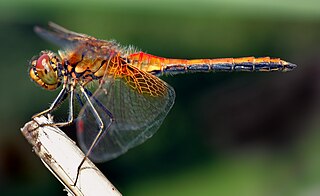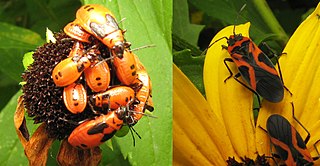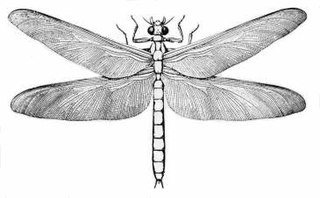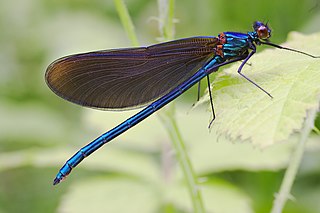
Odonata is an order of flying insects that includes the dragonflies and damselflies. Like most other flying insects, they evolved in the early Mesozoic era. Their prototypes, the giant dragonflies of the Carboniferous, 325 mya, are no longer placed in the Odonata but included in the Protodonata or Meganisoptera.

A dragonfly is an insect belonging to the order Odonata, infraorder Anisoptera. Adult dragonflies are characterized by large, multifaceted eyes, two pairs of strong, transparent wings, sometimes with coloured patches, and an elongated body. Dragonflies can be mistaken for the related group, damselflies (Zygoptera), which are similar in structure, though usually lighter in build; however, the wings of most dragonflies are held flat and away from the body, while damselflies hold their wings folded at rest, along or above the abdomen. Dragonflies are agile fliers, while damselflies have a weaker, fluttery flight. Many dragonflies have brilliant iridescent or metallic colours produced by structural colouration, making them conspicuous in flight. An adult dragonfly's compound eyes have nearly 24,000 ommatidia each.

Damselflies are insects of the suborder Zygoptera in the order Odonata. They are similar to dragonflies, which constitute the other odonatan suborder, Anisoptera, but are smaller and have slimmer bodies. Most species fold the wings along the body when at rest, unlike dragonflies which hold the wings flat and away from the body. An ancient group, damselflies have existed since at least the Lower Permian, and are found on every continent except Antarctica.

In biology, a nymph is the immature form of some invertebrates, particularly insects, which undergoes gradual metamorphosis (hemimetabolism) before reaching its adult stage. Unlike a typical larva, a nymph's overall form already resembles that of the adult, except for a lack of wings. In addition, while a nymph moults, it never enters a pupal stage. Instead, the final moult results in an adult insect. Nymphs undergo multiple stages of development called instars.

Hemimetabolism or hemimetaboly, also called incomplete metamorphosis and paurometabolism, is the mode of development of certain insects that includes three distinct stages: the egg, nymph, and the adult stage, or imago. These groups go through gradual changes; there is no pupal stage. The nymph often has a thin exoskeleton and resembles the adult stage but lacks wings and functional reproductive organs. The hemimetabolous insects differ from ametabolous taxa in that the one and only adult instar undergoes no further moulting.

Meganisoptera is an extinct order of very large to gigantic insects, which may informally be called griffinflies. The order was formerly named Protodonata, the "proto-Odonata", for their similar appearance and supposed relation to modern Odonata. They range in Palaeozoic times. Though most were only slightly larger than modern dragonflies, the order includes the largest known insect species, such as the late Carboniferous Meganeura monyi, Megatypus, and the even larger early Permian Meganeuropsis permiana, with wingspans of up to 71 centimetres (28 in).

The Calopterygidae are a family of damselflies, in the suborder Zygoptera. They are commonly known as the broad-winged damselflies, demoiselles, or jewelwings. These rather large damselflies have wingspans of 50–80 mm and are often metallic-coloured. The family contains some 150 species.

The Lestidae are a rather small family of cosmopolitan, large-sized, slender damselflies, known commonly as the spreadwings or spread-winged damselflies.
Megalagrion oahuense is a species of damselfly in the family Coenagrionidae. It is endemic to Hawaii. It is the only known species of odonate with terrestrial nymphs.
Ophiogomphus howei, the pygmy snaketail, is a species of dragonfly in the family Gomphidae. It is endemic to the United States. Its natural habitat is rivers.

Saga pedo is a species of bush cricket, spread throughout the European part of the Mediterranean, and Asia as far east as China. It is a wingless bush cricket, with the body size of up to 12 centimetres (4.7 in), which makes it one of the largest European insects and one of the world's largest Orthoptera. Colloquially known as the predatory bush cricket, or the spiked magician, it is uncommon among its kind due to its carnivorous lifestyle, most often preying on smaller insects, with a known tendency towards cannibalism as well. For this purpose, it has strong fore and mid legs, equipped with sharp spines. When these animals are hunting, they move about, catching their prey by suddenly leaping on them and grabbing them with their legs. Their prey is usually killed by biting into the throat, and eating is done at capture. Saga pedo is active at dusk and during nighttime, with activity slowly expanding through the day at the end of the season.

Archaeophya adamsi, commonly known as Adam's emerald dragonfly or horned urfly, is a species of dragonfly belonging to the family Gomphomacromiidae. This is an Australian endemic and one of the rarest dragonflies in the country. It breeds in rivers and streams in coastal areas of Queensland and New South Wales.

The Synlestidae are a family of damselflies commonly known as sylphs or malachites. They occur in South Africa, Australia, and South America.

The Synthemistidae are the family of dragonflies commonly known as tigertails, or sometimes called southern emeralds. This family has seven genera and forty-three species; they look similar to corduliid and gomphid dragonflies. This family is sometimes treated as a subfamily of Corduliidae. This is an ancient dragonfly family, with some species occurring in Australia and New Guinea. Most species are small in size and have narrow abdomens. Their nymphs are bottom dwellers, and resist droughts by burying themselves very deeply. Synthemistid dragonflies frequently prefer marshy areas, as well as fast-flowing streams. The family Synthemistidae is sometimes called Synthemidae.

The tau emerald is a species of dragonfly in the family Corduliidae. Corduliidae is the only family not a clade within the Infraorder Anisoptera. The species was first described by Edmond de Sélys Longchamps in 1871.

Diphlebia euphoeoides, sometimes spelled Diphlebia euphaeoides, known as the tropical rockmaster, is an Australian species of broad winged damselfly. It is one of a group known as the azure damselflies. It is found in Queensland (Australia) and Papua New Guinea. It typically occurs near lakes, waterfalls or streams at relatively low altitudes, and is occasionally seen near dry pools.
Odonata are insects with an incomplete metamorphosis (hemimetabolous). The aquatic larva or nymph hatches from an egg, and develops through eight to seventeen instars before leaving the water and emerging as the winged adult or imago.

Synlestes tropicus is a species of Australian damselfly in the family Synlestidae, commonly known as a tropical needle. It is endemic to north-eastern Queensland, where it inhabits streams in rainforests.















